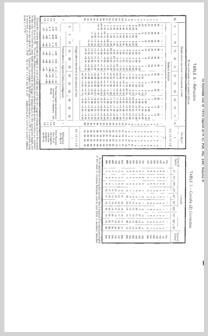
NavList:
A Community Devoted to the Preservation and Practice of Celestial Navigation and Other Methods of Traditional Wayfinding
Re: Refraction
From: Gary LaPook
Date: 2007 Dec 12, 16:16 -0800
From: Gary LaPook
Date: 2007 Dec 12, 16:16 -0800
Gary LaPook wtites: Attached is the refraction table from H.O 249 which has values for negative altitudes since such values are possible from an airplane. gl George Huxtable wrote: >Nicolas wrote- > >"Barents observations were taken at 76°15´.4 N 68°18´.6 O.: >January 24th, 1597 - It was indicated that they saw a glimpse of the sun >January 27th, 1597 - They saw the sun "in zijn volle rondicheyt" (in its >full roundness)" > >Comment from George- > >That, in itself, is a bit contradictory. Seeing "a glimpse of the Sun" is a >very different matter from seeing the Sun "in its full roundness". > >I am presuming that the date given is a new-style Gregorian date, not a >Julian date (the switchover date was a rather complicated matter, in >Holland). In which case, at local noon on the civil day of 27 Jan 1597, the >Sun's altitude was -4d 41' 38", according to Skymap, so it agrees with the >figure quoted.. > >Not unreasonably, the Nautical Almanac predictions for refraction go down >only to an apparent alitude of zero, for which the refraction is given as >33.8'. To see the Sun when it's actually so far below the horizon must be an >extreme case of "ducting" of light, by a strong temperature gradient close >to the surface. I have heard that such effects are not uncommon in Arctic >regions. >================= > >I tried to access the English-language article referred to by Nicolas, but >all I could get, without privileges, was to the abstract. > >Presumably, any argument about Barents' Jupiter-Moon conjunction relates to >Jupiter being theoretically at least 2 degrees below the horizon at the time >the conjunction occurred, on 24 Jan. If the Moon and Jupiter could be seen >together at the time of conjunction, again, there must have been a lot of >abnormal refraction. But I strongly doubt whether any worthwhile longitude >could ever be derived by observing that conjunction. It wasn't a very close >event, the Moon never coming closer to Jupiter than about 3 degrees, so it >would be hard to give a time for that conjunction to within an hour or two, >even if a precise Moon position prediction had been available. It would >depend a lot on the definition of the moment of a conjunction. The >astronomers, compiling an ephemeris, would probably predict it as the moment >when the Moon and Jupiter had the same Right-Ascension (or perhaps the same >ecliptic longitude), but all the observer could do, at a guess, is to time >his best estimate of when they had the same azimuth. Halley used a similar >technique, but he required the Moon and (in his case) star to come much >closer than that. > >I don't see refraction errors, which will usually change the altitude only, >having a big impact on the determination of the moment of conjunction. > >George. > >contact George Huxtable at george@huxtable.u-net.com >or at +44 1865 820222 (from UK, 01865 820222) >or at 1 Sandy Lane, Southmoor, Abingdon, Oxon OX13 5HX, UK. > > >> > > > --~--~---------~--~----~------------~-------~--~----~ To post to this group, send email to NavList@fer3.com To , send email to NavList-@fer3.com -~----------~----~----~----~------~----~------~--~---







